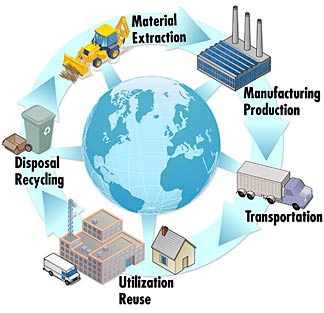Life cycle assessment

A life cycle assessment or life cycle analysis is a technique that is used to assess the potential environmental impacts that are associated with a product, process, or service. Generally this analysis observes a certain product from "cradle to grave", or its entire life cycle including extraction, processing, use, and disposal. Steps in this analysis include:[2]
- Determining what the total energy and material inputs and environmental outputs are
- Evaluating what potential environmental impacts of these inputs and outputs are
- Interpreting the results over the lifetime of the product, process, or service to make an informed decision about if it should be utilized
A life cycle assessment is used when trying to manage greenhouse gases (GHGs), which come from the volume and source of the energy used. This type of analysis can add up the total greenhouse gas emissions from all stages of "life" for a process, product, or service. By looking at the different stages individually it becomes easier to determine where improvements can be made to reduce emissions in places that will make a drastic difference. For example, greenhouse gases are released when a car is driven and gasoline is being burned; but greenhouse gases are also released when extracting the oil to get the gasoline and transporting the oil. As well, when we get rid of the car, the energy it takes to remove or destroy the car contributes to the overall emissions of the car.[3]
As well, a life cycle assessment can be narrowed down to compare options for specific environmental priorities. This could include reducing intrusion on ecologically significant land or reducing greenhouse gases. In general it is more manageable to focus on one pollutant or waste than it is to try and observe all wastes and environmental impacts.[3] Undergoing a life cycle analysis can help financially, as well as environmentally. It does this by looking at different options to improve different aspects of a products life cycle. Options that may have seemed expensive at first glance can actually turn out to be less expensive once costs throughout the entire life cycle are taken into account. For example, GHG emissions (mostly methane from landfills) can be captured and used to provide a source of energy - reducing emissions while providing an additional source of revenue.[3]
For Further Reading
References
- ↑ Wikimedia Commons. (May 25, 2015). Life Cycle Thinking [Online]. Available: http://en.wikipedia.org/wiki/Life_Cycle_Thinking#/media/File:Life_Cycle_Thinking_Product_System.jpg
- ↑ US Environmental Protection Agency. (May 25, 2015). Life Cycle Assessment [Online]. Available: http://www.epa.gov/nrmrl/std/lca/lca.html#define
- ↑ 3.0 3.1 3.2 BC Climate Action Toolbox. (May 25, 2015). Life Cycle Analysis [Online]. Available: http://www.toolkit.bc.ca/tool/life-cycle-analysis

